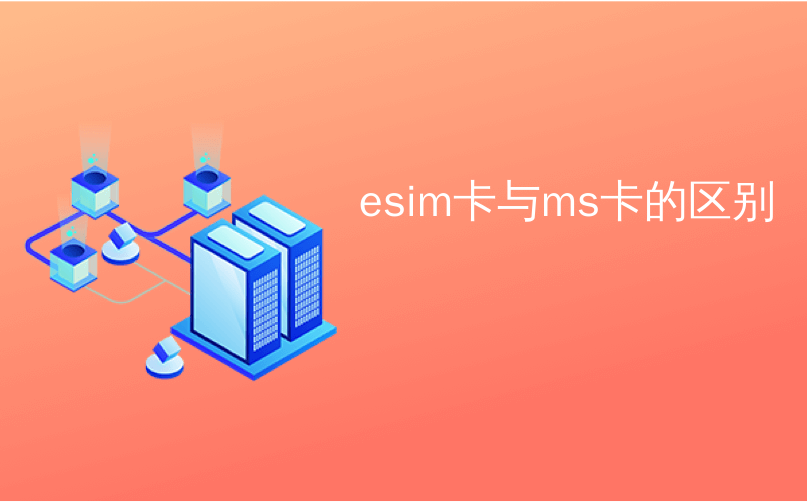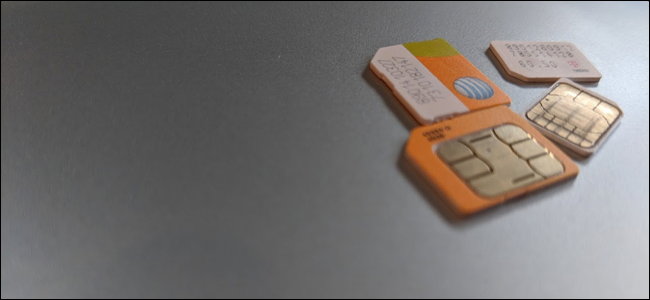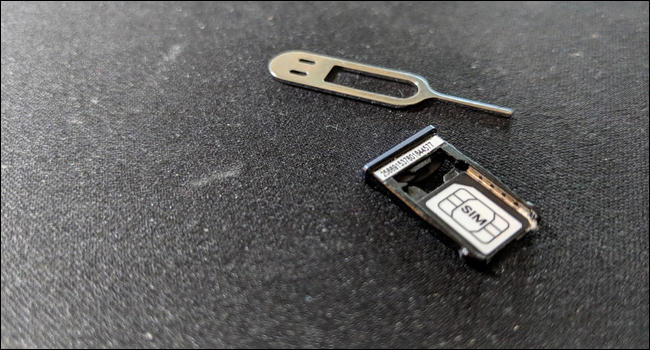
esim卡与ms卡的区别

With the launch of the Apple Watch 3, the term “eSIM” has been thrown around a lot. And now, Google’s Pixel 2 is the first phone to use this new technology, it’s time we take a closer look at what it is, what it does, and what this means for consumers moving forward.
随着Apple Watch 3的发布,“ eSIM”一词已泛滥成灾。 而现在,谷歌的Pixel 2是第一款使用这项新技术的手机,现在是时候让我们仔细研究一下它的功能,作用以及对消费者前进的意义。
什么是eSIM,它们如何工作? (What Are eSIMs, and How Do They Work?)
eSIM is a shortened version of embedded SIM, where SIM is an acronym for Subscriber Identity Module. So, an eSIM is an Embedded Subscriber Identity Module. I’m sure at this point we all know what a SIM card is—the little thing that allows your phone to connect to your cellular provider’s network. When you buy a new phone, you pop out your SIM card, drop it into the new phone, and poof!—cellular service is a go.
eSIM是嵌入式SIM卡的简化版本,其中SIM是订户身份模块的缩写。 因此,eSIM是嵌入式订户身份模块。 我敢肯定,到此为止,我们都知道SIM卡是什么,这是使您的电话能够连接到移动运营商的网络的小物件。 当您购买新手机时,您会弹出SIM卡,将其放入新手机中,然后po! -移动服务是一门必经之路。
That’s going to change with eSIM, because as the “embedded” part of the name suggests, this is actually built into the phone’s mainboard. It’s rewritable, similar to an NFC chip, and will be compatible with all the major carriers, regardless of what type of network they use.
eSIM会改变这种情况,因为顾名思义,“嵌入式”部分实际上是内置在手机主板上的。 它可擦写,类似于NFC芯片,并且将与所有主要运营商兼容,无论它们使用哪种网络。
The Apple Watch 3 and Pixel aren’t the only devices using eSIMs. Cars do too—we’ve all seen a connected car at this point, and you may have ever wondered where its SIM card is. The short answer is that it’s using an eSIM. That’s one application where it really just makes sense.
并非只有Apple Watch 3和Pixel可以使用eSIM。 汽车也是如此-我们在这一点上都已经看到过联网汽车,您可能曾经想知道它的SIM卡在哪里。 简短的答案是它正在使用eSIM。 那是一个真正有意义的应用程序。
Other manufacturers of connected devices—usually smarthome devices—are also using eSIMs. It just makes sense: it’s less hassle for the customer, more connection options for the manufacturer. And for those types of applications, it really is a win-win. When we start talking about bringing this tech to smartphones, however, its gets a little fuzzier.
其他连接设备制造商(通常是智能家居设备)也使用eSIM。 这很有意义:给客户带来的麻烦减少了,为制造商提供了更多的连接选择。 对于那些类型的应用程序,这确实是双赢的。 但是,当我们开始谈论将这项技术应用于智能手机时,它会变得更加模糊。

Like I mentioned earlier, right now when you want to switch phones, you pop your SIM card out and drop it in the new handset. With an eSIM, you’ll have to actually talk to your carrier, which I personally think is a step backwards—I can change SIM cards in a matter of seconds, all without ever having to actually (ugh) call someone. That said, there are other opportunities here—perhaps carriers will release connectivity apps that allows you to quickly activate your phone on their network. I’m not saying that’s going to happen, but I am suggesting it’s a legitimate possibility.
就像我之前提到的,现在,当您要切换手机时,将SIM卡弹出并放到新手机中。 使用eSIM,您实际上必须与您的运营商联系,我个人认为这是一个倒退—我可以在几秒钟内更换SIM卡,而无需真正地(ugh)打电话给某人。 也就是说,这里还有其他机会-运营商可能会发布连接性应用程序,使您可以在其网络上快速激活电话。 我并不是说这会发生,但是我建议这是一个合理的可能性。
eSIM的好处 (The Benefits of eSIMs)
That may sound inconvenient, but the benefits pretty strongly outweigh the cons (which we’ll get into down below).
这听起来可能很不方便,但好处远大于缺点(我们将在下面介绍)。
First off, since device manufacturers won’t have to accommodate a SIM card slot in their phones, they’ll have even more flexibility in terms of design. With the SIM card actually embedded into the device’s internal hardware, bezels could theoretically shrink, phones could perhaps get slightly thinner without sacrificing battery, and a lot more. That’s precisely why Apple chose to use an eSIM in the Watch 3—it makes so much sense in a small form factor device like a smartwatch.
首先,由于设备制造商不必在手机中容纳SIM卡插槽,因此它们在设计方面将具有更大的灵活性。 由于SIM卡实际上已嵌入设备的内部硬件中,因此边框在理论上可能会缩小,电话可能会变得更薄一些而不会牺牲电池电量,甚至更多。 这就是苹果选择在Watch 3中使用eSIM的原因-在像智能手表这样的小尺寸设备中它意义非凡。
Also, this could be a game changer for international travelers who have to swap SIM cards, services, or even carry more than one phone to stay connected. Instead of having to pop into a local cellular provider store to get a new SIM card when travelling abroad, imagine just being able to make a quick phone call (or, like I suggested earlier, open an app) and boom—coverage. All without having to jump through hoops or change phones.
此外,对于需要交换SIM卡,服务甚至携带不止一个电话才能保持联系的国际旅行者来说,这可能是一个改变游戏规则的人。 而不是流行到本地手机供应商店在国外旅行时获得一个新的SIM卡,只是想象能够做出快速的电话(或者,就像我刚才所说,打开应用)和吊杆-coverage。 无需跳铁圈或更换手机。
eSIM的挑战 (The Challenges of eSIMs)
There is a catch, though: adoption. Before we can make the leap over to eSIM, every major carrier is going to have to agree that eSIMs are the future. Then, phone manufacturers will have to follow suit. If you know how this industry works, those kind of things take time.
不过有一个陷阱:收养。 在我们过渡到eSIM之前,每个主要的运营商都必须同意eSIM是未来。 然后,电话制造商将不得不效仿。 如果您知道该行业的运作方式,则需要花费一些时间。
But it starts with one carrier, which will then grow to two, and so forth. Like I mentioned earlier, Google’s Pixel 2 is the first smartphone to use an eSIM, but that’s only if you’re using the phone on Project Fi. For all others, it still uses a traditional SIM.
但是它从一个载波开始,然后将增长到两个,依此类推。 就像我之前提到的,Google的Pixel 2是第一款使用eSIM的智能手机,但这仅在您在Project Fi上使用手机时才可以。 对于其他所有应用程序,它仍然使用传统的SIM卡。
And, as we mentioned before, switching phones can be a bit more time-consuming. You can swap your SIM card out in seconds, where the change to eSIMs will take longer to do the same thing. While I realize this won’t affect most people, that’s a real hassle for someone like me, who may switch a SIM card for just a few minutes to test something on a specific phone.
而且,正如我们之前提到的,切换电话可能会更加耗时。 您可以在几秒钟内换出SIM卡,而更改为eSIM所需的时间将更长。 虽然我意识到这不会影响大多数人,但对于像我这样的人来说却是一个真正的麻烦,他们可能只需切换几分钟即可在特定手机上测试SIM卡。
But I get it: I’m not the majority here, and I’m cool with that. For most people, I think eSIMs will be great—especially those who may not be so tech savvy. You’d be shocked at how many people don’t know how to swap out a SIM card and are honestly completely freaked out by the idea of it (hi, Mom!). For those people, eSIMs are going to be great.
但是我明白了:我不是这里的大多数,对此我很酷。 对于大多数人来说,我认为eSIMs会很棒-特别是那些可能不那么精通技术的人。 您会惊讶于有多少人不知道如何换出SIM卡,而老实说完全被它的想法吓坏了(嗨,妈妈!)。 对于那些人来说,eSIM将会很棒。
Considering we’ve already seen two flagship devices—the Apple Watch 3 and Google Pixel 2—ship with eSIMs just this year, I have a feeling this little chip is about to get a lot bigger. More manufacturers will start including this in their handsets over the next year or so, and carriers will also begin adopting compatibility for their networks. We’ll likely still see traditional SIM setups (at least on phones) for the next little while, but I have no doubt that eSIMs will eventually take over completely.
考虑到我们已经在今年看到了两款旗舰设备-Apple Watch 3和Google Pixel 2-随eSIM一起发售,我感到这个小芯片将要变得更大。 明年左右,更多的制造商将开始在手机中包括此功能,运营商也将开始对其网络采用兼容性。 在接下来的一段时间内,我们可能仍会看到传统的SIM卡设置(至少在手机上),但是我毫不怀疑eSIMs最终将完全取代。
翻译自: https://www.howtogeek.com/331442/what-is-an-esim-and-how-is-it-different-from-a-sim-card/
esim卡与ms卡的区别
今天的文章esim卡与ms卡的区别_什么是eSIM,它与SIM卡有何不同?分享到此就结束了,感谢您的阅读。
版权声明:本文内容由互联网用户自发贡献,该文观点仅代表作者本人。本站仅提供信息存储空间服务,不拥有所有权,不承担相关法律责任。如发现本站有涉嫌侵权/违法违规的内容, 请发送邮件至 举报,一经查实,本站将立刻删除。
如需转载请保留出处:https://bianchenghao.cn/84306.html
